 Chimney stacks and pots – Spotting and collecting
Chimney stacks and pots – Spotting and collecting
Few people collect chimneys (although there is bound to be someone out there who does) but there are people who do take more than a passing interest in chimney 'spotting'. While chimney pots have a definite collectors' market, a dedicated museum, and a society for their protection and preservation.
A brief history of chimneys, chimney stacks and chimneys pots
Chimneys have been an important part of buildings for centuries – particularly in colder climates where there is a need to retain heat but remove smoke, and prevent downdrafts. In British architecture, they were first found in castles (often these were just a simple chute with plain openings), and then in manor houses.
It was in manor houses that the first of what today would be called chimney pots appeared. And in the Tudor period it became fashionable to have very ornate brick chimneys and stacks. While much simpler versions of chimney pots became common on ordinary homes around the Elizabethan period.
A chimney is the entire structure that carries off the smoke from a fire. Rather oddly, to modern eyes, some early chimneys were made from wood – until the practice was outlawed by early fire prevention laws.
According to the Oxford English Dictionary, 'Chimney' originally meant a fireplace, and is thought to be derived from the Latin Caminus, meaning furnace, forge or oven. In Middle English it was 'Chimenee'.
In modern English, a chimney stack is understood to be the part of the chimney or flue that is visible above the roof. However, originally, these were called chimney stalks, and a cluster of stalks was called a stack.
Chimney pots are a superstructure of the stack, ie. they sit on top of the stack.
The Victorian era was the 'Golden Age' for chimney pots. This is largely thought to be due to the amount of identical terrace houses that were built during this period – which led to people using chimney pots as a way of personalising them.
Even though there were literally thousands of different designs of chimney pots there are surprisingly few books on the subject. Indeed, 'Chimney Pots and Stacks' by Valentine Fletcher, published in 1968, is believed to be the first specialised book on the subject. And this was at a time when the Clean Air Act and gas fired central-heating meant log and coal fires in homes were going out of fashion – together with the need for chimneys and pots.
Valentine Fletcher coined the word 'Caminology' to denote the study of chimneys. However, there doesn't appear to have been many (if any) later studies on the subject, and the word does not appear in the Oxford English Dictionary.
Although many of Hatfield's old buildings were demolished to make way for the postwar New Town, there are still enough old buildings in and around the town to see a varied selection of types of chimney pots, and ornate brick stacks. And they are still being added to houses built today.
Brick Chimney Stacks
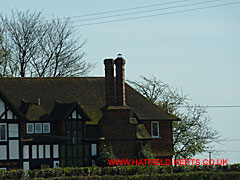
Tall twin Tudor-style brick stacks at Cromer Hyde Farm. The fresh look of the brickwork suggests these have either been renovated or replaced.
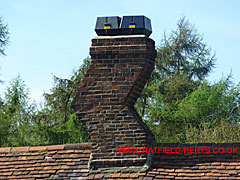
The Crooked Chimney on the pub of the same name at Cromer Hyde. Clearly, with modern extraction units for pots, this brick chimney has been modified. The deliberate kink in the stack is probably to deflect rain or prevent downdrafts. Especially before the Industrial Revolution there were regional traits in chimney stacks and pots. Crooked chimneys are thought to be native to the Chichester area, and date back to the Georgian period.
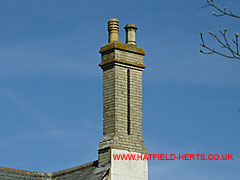
Lemsford Cottage has at least two chimneys – shown here is a two pillared buff colour brick stack, joined at the crown with two unusual pots (described under chimney pots)
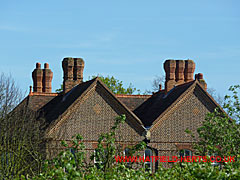
The brick stacks on the roof of Woodhall Farm – as seen from the Stanborough Lakes end.
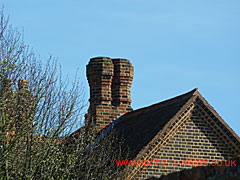
Close up of the brick twin stack on the left gable

Close up of the brick triple stack on the right gable. The fresh state of the brickwork suggests recent renovation, although the state of the top suggests these may be originals (although whether they are as old as the rest of the building is a different matter).
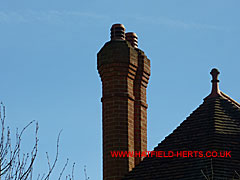
Seen from a different angle, the twin stack on the far left is actually much taller. This is in order for it to be clear of the sloping roof which acts as a windbreak and would affect the pressure inside the chimney, which in turn would impact on its ability to conduct the smoke out of the building. The twin stacks are topped by what appears to be a type of Three Ring Louvre chimney pot (if it just sits on top it's known as a Top, if it has a lower section with a smaller diameter that would slot inside an existing pot or opening then it would be called a Spigot).
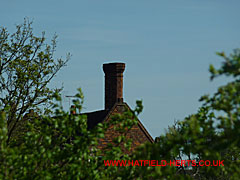
Large brick columnar stack on an adjoining building. This may be for a smokehouse (used to cure meat) and the wider girth would allow a larger than usual amount of smoke to clear when needed. Or it may be a status symbol dating back to the days when people's homes were taxed on the basis of the number of fires that they had. This was later replaced by a Window Tax.
Click here for more information on Window Tax...
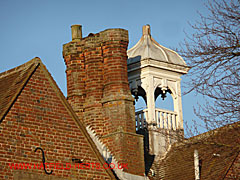
Trio of brick stacks on top of Nast Hyde House. The stack at the far end appears to have been fitted with a metal cap or terminal to prevent water entering the building, which suggests the stack is not in use. The pepperpot turret-like structure next to it would probably have been a belfry and may be a relic of the time the building was used as a school
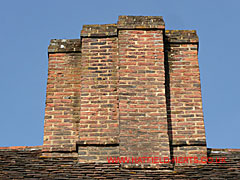
The main chimney of the former Chequers Pub in Old Hatfield appears to be several stacks joined together in an irregular fashion. However, this large central brickwork stack may have been a deliberate design feature, common in the 17th Century, where it acted as a central support column and allowed shorter timbers to be used.

The main brick and tile chimney of the Hatfield Arms. Once the Great Northern Hotel perhaps this elaborately decorated stack (which is larger than the others) was meant to represent the funnel of a steam engine.

Probably the most stunning example of chimney brickwork in the town area can be found on top of the former Salisbury Arms restaurant in Old Hatfield. The 'star' design is thought to have originated in the Midlands
Click here for Chimney Pots and Stacks – Part 2
Back to: Hobbies and Collections